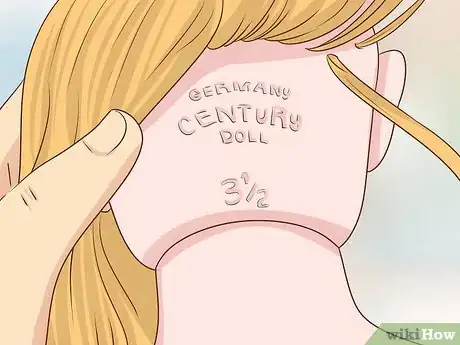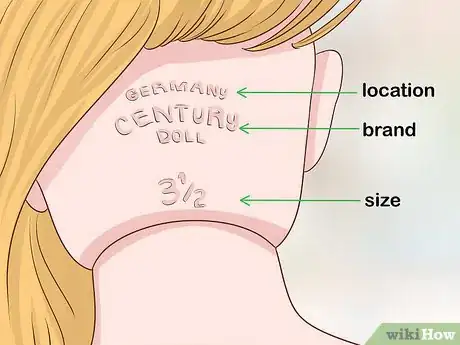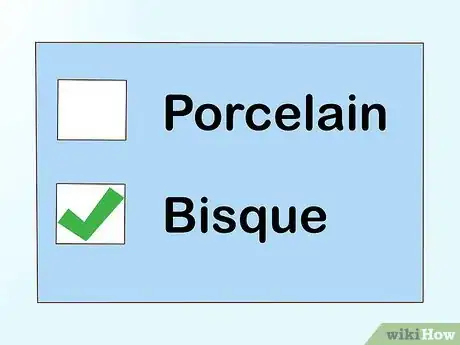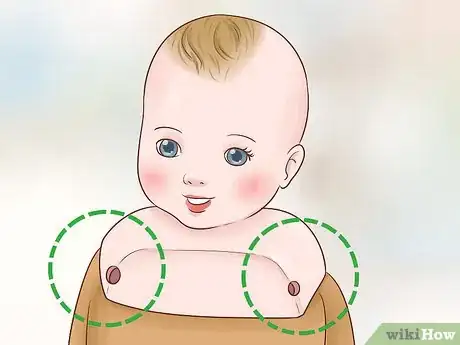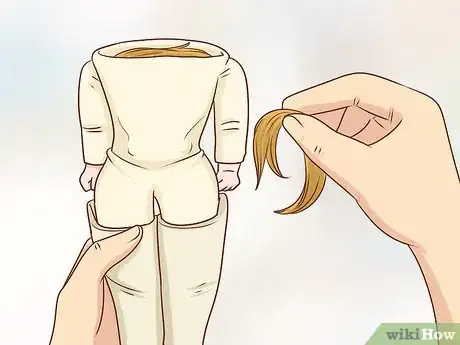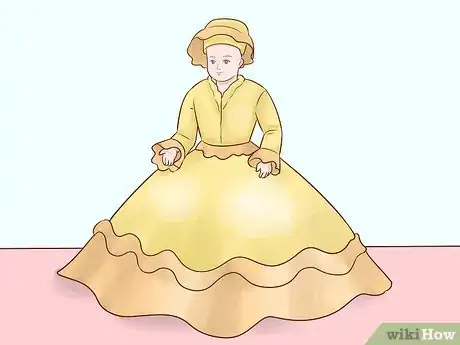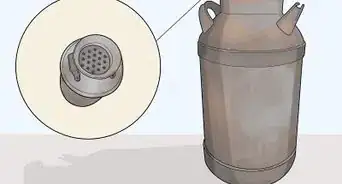This article was co-authored by wikiHow Staff. Our trained team of editors and researchers validate articles for accuracy and comprehensiveness. wikiHow's Content Management Team carefully monitors the work from our editorial staff to ensure that each article is backed by trusted research and meets our high quality standards.
wikiHow marks an article as reader-approved once it receives enough positive feedback. In this case, several readers have written to tell us that this article was helpful to them, earning it our reader-approved status.
This article has been viewed 163,122 times.
Learn more...
Collecting antique dolls is a popular hobby that can be both enjoyable and used as an investment for the collector. Checking the manufacturer's mark is the best way to identify the type and era of an antique doll. However, you can also use the appearance of porcelain and bisque dolls to help identify if they are antique. If you are in doubt regarding the identification of your doll, contact a professional doll appraiser for an accurate opinion.
Steps
Checking the Manufacturer's Mark
-
1Check the back of the head for the manufacturer's mark. Lift up the hair of the doll if it has a wig. Most antique dolls will have a manufacturer's mark on the back of the head, or on the base of the neck.[1]
- If the doll doesn't have a manufacturer's mark anywhere and you still suspect that it could be antique, contact a professional doll appraiser for help.
- Although the mark is most commonly on the back of the head or neck, they can be located anywhere on the body. Check the back, under the arms, or on the bottom of the feet.[2]
-
2Read the manufacturer's mark. This mark will often have the the location where the doll was made, the brand or maker's name, and the size of the doll. The interpretation of the size numbering differs between each brand and maker of dolls.[3]Advertisement
-
3Use the manufacturer's mark to browse reference books and websites. The manufacturer's mark will often give you all of the information that you need to identify the doll. Visit your local library, or use a search engine to find a doll reference website that uses the manufacturer's information to identify the doll.[4]
- These guides will also give you information about the value of the doll.
- This is the most accurate way of identifying the doll, as it can be difficult to rely solely on the appearance.
-
4Seek professional help if you cannot identify the doll. If finding or interpreting the manufacturer's label is difficult, contact a doll appraiser for help. They will be able to identify the type, era, and value of the doll accurately.[5]
Identifying Porcelain and Bisque Dolls
-
1Check that the doll is made from porcelain or bisque and 1 other material. Hold the head of the doll to your teeth. If it feels hard and cold, this means that it's made of porcelain or bisque. The body of the doll is usually made from a different material, such as kid (soft leather) or cloth.[6]
- Other materials that the body of these dolls are often made from include composition (sawdust, wood, and glue), ceramic, and paper-mache.
- Bisque is unglazed ceramic porcelain. It has small pores that collect dust and dirt. Usually the more dirt in the pores, the older the doll is.[7]
-
2
-
3Look at the stuffing of the doll if possible. Antique dolls that have bodies made out of kid or cloth are usually stuffed with sawdust or horsehair. The stuffing will be very tight so that it can support the weight of the head.[10]
- Antique dolls will never be loosely stuffed, or stuffed with polyester.
-
4Look for craze lines on the porcelain or bisque surface of the doll. These antique dolls develop fine lines as they age, which look like cracks scattering across the porcelain or bisque. These will often be across the face of the doll.[11]
- For example, a doll with very heavy cracks across the face is very old.
-
5Check that the coloring of the doll is faded and discolored. A dull face coloring is a signature mark of an antique porcelain or bisque doll. The eyes, cheeks, and lips of the doll will look dull.[12]
-
6Inspect the eyes of the doll for an indication of its age. These antique dolls that were made before 1870 had eyes that were painted on. From 1870 to the early 1900s, the dolls had inset glass eyes which don't move. From the early 1900s, the eyes of the dolls are large and rounded, with a sideways glance.[13]
- The painted eyes of dolls made before 1870 are usually light blue, however some are brown or black.
-
7Check that the hair of the doll is painted on. The majority of antique dolls have painted hair, which is black, brown, or blonde. The only exception is for German antique porcelain dolls, which often have wigs that are made out of mohair or human hair.[14]
- Red hair is very uncommon in antique porcelain dolls as it was believed to be unlucky.
- German porcelain dolls will have wigs that are glued onto the head, as opposed to rooted wigs which is common in newer dolls.
- Mohair is the hair of an angora goat.
-
8Make sure that the clothes are old and faded. Clothes are an easy way to identify antique dolls, as the older the clothes appear, usually the older the doll itself too. The clothes will often be dull, have signs of dust, and may be damaged.[15]
- Antique dolls will never have modern velcro fastenings.
- Check the inside of the clothing for any tags that may give you more information about the doll.[16]
References
- ↑ https://ourpastimes.com/tell-antique-reproduction-bisque-dolls-7722846.html
- ↑ https://dollreference.com/doll_marks.html
- ↑ https://www.antiquedolls-collectors-onlineadvisors.com/antique-doll-identities.html
- ↑ https://www.antiquedolls-collectors-onlineadvisors.com/antique-doll-identities.html
- ↑ https://hobbyzeal.com/how-to-identify-antique-porcelain-dolls
- ↑ https://hobbyzeal.com/how-to-identify-antique-porcelain-dolls
- ↑ https://www.mearto.com/toys-and-dolls/dolls
- ↑ https://hobbyzeal.com/how-to-identify-antique-porcelain-dolls
- ↑ https://www.antiquedolls-collectors-onlineadvisors.com/antique-doll-identities.html
- ↑ https://ourpastimes.com/tell-antique-reproduction-bisque-dolls-7722846.html
- ↑ https://hobbyzeal.com/how-to-identify-antique-porcelain-dolls
- ↑ https://hobbyzeal.com/how-to-identify-antique-porcelain-dolls
- ↑ https://hobbyzeal.com/how-to-identify-antique-porcelain-dolls
- ↑ https://hobbyzeal.com/how-to-identify-antique-porcelain-dolls
- ↑ https://hobbyzeal.com/how-to-identify-antique-porcelain-dolls
- ↑ https://www.antiquedolls-collectors-onlineadvisors.com/antique-doll-identities.html
- ↑ https://hobbyzeal.com/how-to-identify-antique-porcelain-dolls
About This Article
Collecting antique dolls can be a fun and profitable hobby, if you know what you’re looking for. Lift up the hair on the back of the doll’s head to look for the manufacturer’s mark. Typically, the mark will tell you where the doll was made, the brand or maker’s name, and the size of the doll. Use this information to look up your doll in reference books and on websites. If you can’t find any information on your doll or have a hard time interpreting the information, contact a doll appraiser for help, who can help you identify the type, era, and value of the doll. To learn how to tell a porcelain from a bisque doll, keep reading!
